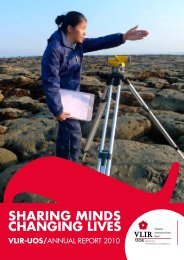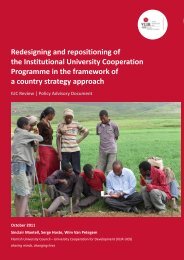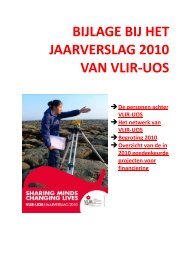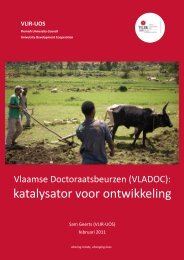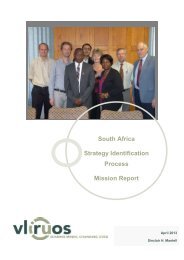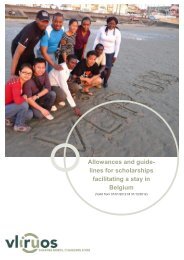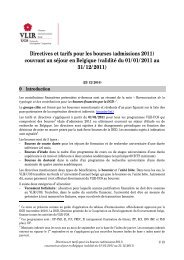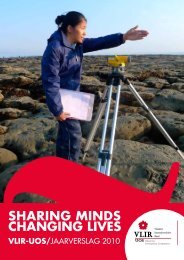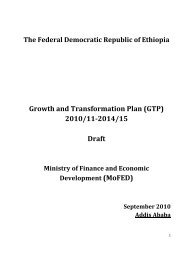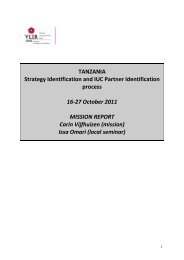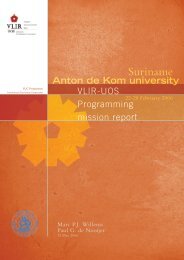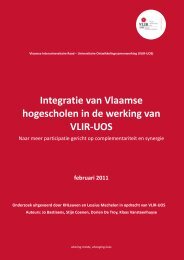Education Sector Development Program - VLIR-UOS
Education Sector Development Program - VLIR-UOS
Education Sector Development Program - VLIR-UOS
You also want an ePaper? Increase the reach of your titles
YUMPU automatically turns print PDFs into web optimized ePapers that Google loves.
<strong>Education</strong> <strong>Sector</strong> <strong>Development</strong> <strong>Program</strong> IV<br />
The enrolment<br />
capacity of the existing<br />
22 universities will<br />
be enhanced, with<br />
particular focus on<br />
access to programs<br />
related to Science and<br />
Technology/ S&T, and<br />
nine new universities will<br />
be constructed.<br />
2. Expected <strong>Program</strong> outcomes<br />
• A balanced distribution of higher education<br />
opportunities throughout the country through<br />
the widening of access to higher education,<br />
in particular to science and technology<br />
• Improved teaching learning process,<br />
increased interpersonal growth and improved<br />
employability through high quality higher<br />
education and relevant professional mix with<br />
equitable participation of both sexes.<br />
• Improved access to and success in higher<br />
education of traditionally disadvantaged<br />
groups such as females, people from rural<br />
and pastoralist communities and people with<br />
special needs<br />
• Enhanced capacity of HEIs for knowledge<br />
creation and transfer as well as community<br />
and consultancy services to the economy<br />
and society at large, in line with the country’s<br />
socio-economic needs<br />
• Strengthened good governance,<br />
management and leadership capacity at the<br />
systems and institutional levels for enhanced<br />
performance and accountability.<br />
Key outcome targets<br />
Transition rate from preparatory to higher<br />
education will increase from 81% in 2008/2009<br />
to 95% in 2014/15<br />
Total enrolment in undergraduate higher<br />
education (regular government program) will<br />
increase from 185,788 in 2009/10 to 467,445<br />
in 2014/15<br />
Share of female enrolment will increase<br />
from 29% in 2009/10 to 40% in 2014/15<br />
Ratio of intakes Science and technology to<br />
Social Sciences and Humanities will evolve<br />
from 58:42 in 2008/2009 to 70:30 in 2014/15<br />
Admission for post graduate program will<br />
increase from 4,878 in 2009/10 to 16,100 by<br />
2014/15 (3000 PhD)<br />
Share of females for post graduate 10% in<br />
2009/10 to 25% by 2014/15<br />
Graduation Rate 1 will increase from 79% in<br />
2009/10 to 93% in 2014/15<br />
Staff to student ratio will evolve to 1:25 for S&T,<br />
1:15 for medicine and health sciences, 1:20 for<br />
agriculture and life sciences, and 1:30 for social<br />
and human sciences (SHS) by 2014/15<br />
Number of teachers by 2014/15 will be 23,000,<br />
including (75%) masters and (25%) PhD<br />
1 Graduation rate is calculated by dividing the number<br />
of graduates by the number of students admitted at the<br />
beginning of the program (similar to a cohort survival rate).<br />
Share of female academic staff will be 20% of<br />
the total<br />
Number of females in top leadership positions<br />
will increase from 3 in 2009/10 to 16 in 2014/15<br />
Number of quality audited HEIs will increase<br />
from 20% in 2008/2009 to 100% in 2014/15<br />
Number of technology institutes by 2014/15 will<br />
be 10<br />
Number of universities that generate sufficient<br />
income by 2014/15 will be 22 universities<br />
Number of Science and Technology universities<br />
by 2014/15 will be 2<br />
Number of universities that opened their own<br />
branch by 2014/15 will be 6<br />
Number of Strategic Planning Agreements with<br />
universities approved will be 31 in 2014/15<br />
Pervasiveness of Good Governance in Public<br />
Institutions by 2014/15 in 31 universities<br />
Satisfaction of students and academic staff with<br />
administrative services will be 80% in 2014/15<br />
3. Policy and Strategies<br />
A series of policies and strategies will be<br />
deployed in order to reach the strategic program<br />
outcomes. They cover the policy angles of access,<br />
quality, equity and governance and are thus<br />
intended to form a coherent and comprehensive<br />
set of actions.<br />
They fully take into account the policy guidelines<br />
provided under the 2008/2009 Conversion Plan<br />
which lays major emphasis on the development<br />
of Science and Technology/ S&T as a major<br />
driver to turn Ethiopia into a middle income<br />
country by the year 2025. They also embrace the<br />
directions provided by the new Higher <strong>Education</strong><br />
Proclamation of 2009/10, which indicates both<br />
desirable policy and structural changes for the<br />
higher education sector, not only for ESDP IV but<br />
beyond.<br />
The basic philosophy of the higher education<br />
component of ESDP IV is to expand the system<br />
more equitably across the country while seeking<br />
to improve quality. For this reason, the enrolment<br />
capacity of the existing 22 universities will be<br />
enhanced, with particular focus on access to<br />
programs related to Science and Technology/ S&T,<br />
and nine new universities will be constructed and<br />
equipped, with special emphasis on programs in<br />
Science and Technology. To increase the capacity<br />
of the universities special attention will be given<br />
to finalize the construction on time and on the<br />
provision of equipment and furniture.<br />
The provision of undergraduate and graduate<br />
programs in public universities is aimed to ensure<br />
relevance and quality in general and to enable<br />
the sub-sector in bringing change through giving<br />
64



